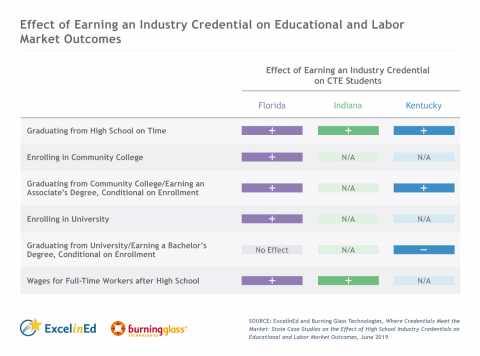


States can—and should—graduate students from high school prepared for the challenges of college and careers. Many states are working toward this goal by improving the quality of career and technical education (CTE) programs and have looked to industry-recognized credentials as one component of this improvement. However, there is limited research on education and labor market outcomes associated with earning an industry credential in high school.
A new report from ExcelinEd and Burning Glass Technologies, Where Credentials Meet the Market: State Case Studies on the Effect of High School Industry Credentials on Educational and Labor Market Outcomes, addresses that gap.
Where Credentials Meet the Market builds on the foundation laid in Credentials Matter: A National Landscape to examine the impact of credential attainment on long-term student outcomes. This second report analyzes the credentials students earn in high school and their impact on students’ secondary completion, postsecondary enrollment and completion as well as wage earnings. It provides insights into the return on investment of earning a credential in Florida, Indiana and Kentucky—three states that collect rich, student-level data that includes credential attainment at the student level.
View this table as a full-size image.
Overall, the report finds that earning a credential is associated with positive outcomes related to high school completion, community college enrollment and completion, and wages.
*Postsecondary outcomes need additional research to determine if rigor of study or cost of higher education for credential earners has an impact on bachelor’s degree attainment.
Based on these findings, Where Credentials Meet the Market has identified five specific recommendations for states to consider as they design education-to-career pathways for students.
Read "Where Credentials Meet the Market"
About Credentials Matter
Credentials Matter is an ongoing research partnership between ExcelinEd and Burning Glass Technologies designed to shed light on the landscape of industry credential data collection and alignment across the country. The project provides insight into how industry credentials earned by high school students align with workforce demand in each state to inform education system improvements and state data collection practices. Visit ExcelinEd.org/CredentialsMatter for more information.
Credentials Matter was made possible by a grant from Carnegie Corporation of New York. The statements made and views expressed are solely the responsibility of the authors.
Have Too Many Bad Habits? Here Are
6 Ways To Create Good Ones
It’s said that we become our habits. In some cases that is not a good thing; bad habits prevail among many Americans. One report found that over 70 percent of US adults have at least one unhealthy behavior associated with chronic health problems.
Breaking bad habits isn’t easy, but sometimes the best answer is replacing them with empowering new habits that bring positive changes to one’s daily life.
“We often have habits that hold us back, like smoking or eating food lacking in nutrition,” says Dr. Rob Carter III, co-author with his wife, Dr. Kirti Salwe Carter, of The Morning Mind: Use Your Brain to Master Your Day and Supercharge Your Life(www.themorningmind.com).
“A great way to start every day is with a series of empowering habits. Morning, in fact, according to some researchers is the best time to start making these kinds of changes in your life.”
Carter has six ways you can create new, empowering habits and make them stick:
Prioritize habits. “For each area in which you want to grow,” Carter says, “take some time to think about what kind of empowering habits you’d like to establish around that topic.” Areas to consider are health, wealth, social, relationships, job, hobbies, self-esteem, interpersonal skills, positive thinking, time management, and life purpose.
Focus on one at a time. “Because we have a limited amount of willpower in the morning, it’s very important how we use that energy,” Carter says. “By focusing on just one habit you would like to change – for example, eating a healthy breakfast – you can concentrate that willpower on the task at hand until it becomes a habit.”
Be reasonable with yourself. The time it will take to establish the new habit depends upon how much resistance a person has. And sometimes developing a new habit represents a long leap from where one currently stands. “That’s too daunting,” Carter says, “so break it down into more achievable steps. Incremental improvements add up to a big transformation and are often more powerful and sustainable.”
Commit specific time toward the goal. Carter suggests nailing down a detailed timeline and committing a full effort toward formation of the new habit within that time span. “Write down what you hope to achieve, how many times a week you will practice the new habit, and when and where you’ll do it,” Carter says. “Having a specific goal helps keep you accountable to yourself.
Reward success. Have a reward in place to celebrate performing your new habit. “It has to be something that will motivate you to complete your habit,” Carter says.
Stack habits. “The neural pathways of your pre-existing habits are well-travelled routes in your brain,” Carter says. “You can take advantage of this by building a new habit and associating it with an old one that is well-established. This is a quicker way to create new habits than if you were to start from scratch. For example, if you want to create a new habit of exercising in the morning, and you have a habit of reading the newspaper every morning, tie these activities together by exercising immediately before you read the paper. Reading the paper becomes your reward.”
“When you learn for yourself how simple it is to change habits,” Carter says, “you’ll want to make adjustments to all areas of your life.”
About Dr. Rob Carter III and Dr. Kirti Salwe Carter
Dr. Rob Carter III and Dr. Kirti Salwe Carter are co-authors of The Morning Mind: Use Your Brain to Master Your Day and Supercharge Your Life (www.themorningmind.com). Rob Carter is a Lieutenant Colonel in the U.S. Army, an expert in human performance and physiology, and has academic appointments in emergency medicine at the University of Texas Health Science Center at San Antonio, in public health and health sciences at Los Angeles Pacific University, and in nutrition at the University of Maryland, University College. He holds a PhD in biomedical sciences and medical physiology and an MPH in chronic disease epidemiology.
Kirti Carter was born in Pune, India, and received her medical education in India, where she practiced as an intensive-care physician before moving to Texas to complete postgraduate training in public health. She is a Fellow of the American Institute of Stress (FAIS), has more than 18 years of experience in meditation and breathing techniques, and has been facilitating wellness seminars for the past decade.
=================
Reaching out to let you know about Dragon Federation, a Sandy-based tech and gaming company. I think their new pets - "real" dragons - will resonate with your readers. These local entrepreneurs created a whole world with a physical egg and an augmented and virtual reality app.
The Dragon Federation wants to make your next pet a dragon. Dragon Federation will launch 10 styles of dragon eggs and a proprietary mobile app on Kickstarter next Tuesday, June 11. They're looking to raise $30,000 in order to produce the dragon eggs professionally and at scale. They plan to produce all eggs in the USA.
Click here for the Kickstarter preview link
I've attached the press release, and media kit is available on Dropbox (click here)
Click to view the Product Demo Video
Co-Founders Samson Madsen and Michael Madsen are available for interviews.
Quick Overview:
The Dragon Federation wants to make your next pet a dragon. The idea was born when Co-Founder Samson Madsen's kids wanted a pet. Instead of a dog or a cat, he thought: ‘Why not a dragon?’ These physical eggs, from the Mountain Skál species, come with a mobile app that allows owners to form a bond with their baby dragon and track its growth. Once hatched, owners use Augmented Reality to interact with the dragon in the real world. In 2020, owners will use Virtual Reality to go into the dragon realm where they can play, train, and even ride on their dragon's back.
A Bit of Lore:
Ages ago, when dragons were hunted near to extinction, the ancient Federation of Dragons sent them to their own world, the Dragon Realm, where they would be safe. Dragon Federation is the modern iteration of the Federation of Dragons, and has developed technology to peer into and even enter the dragon realm. Dragon Federation is recruiting new members who want to join the Federation, protect these mythical creatures and create a world where humankind and dragonkind can live together peacefully.
===================